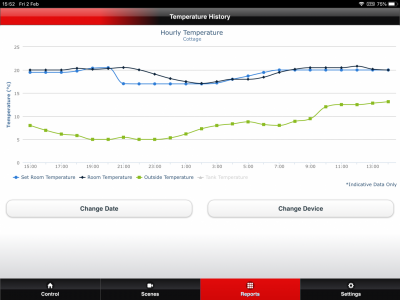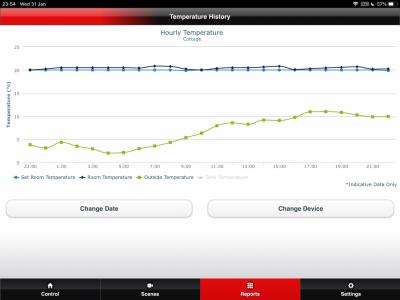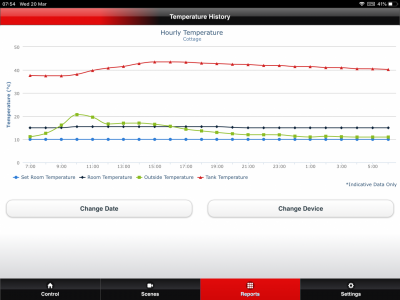Creative trials on Night-time Setbacks to @ faster recovery, improved comfort and even greater energy reductions.
I would certainly agree that the heat pump operation is causing an increase in defrost cycles and also a reduction in efficiency.
Definition of setback.
we have tried different set back temperatures to see what fits our Low mass building. In other words our house warms up quickly but it also cools down relatively quickly. We also have radiators rather than a high mass slow release slab of under floor heating so efficiency is somewhat curtailed by the properties of our house. So we are having to try and make the most of what we have.
We are operating a setback from daytime 21c back to 17c between the hours of 9pm and 4am. The ramp up in the morning starts at 4am and is achieved in 1c increments with 1.5 hours between each 1c rise taking our set temperature up to 20c. The incremental rises are designed to keep the Auto Adaptive controller operating at a minimal output so that the feedback loop doesn’t see large temperature rise targets. The 21c room temp is achieved by Auto Adaptive always over running the target by half or one degC.
There have been several observations about how the system works along the way to finding the best setting for the widest outside temperature ranges. If ever there was a system which didn’t want to be controlled it would be the Heat Pump.
Nonetheless we have persevered and found several ‘unknown unknowns’ and turned many into ‘known unknowns’.
Perhaps the most surprising of these has been to understand ‘Freeze Stat Function.’
Just when you think you have everything under control Freeze Stat Function decides to switch on at 2am and operate right through to the morning ramp up.
CAUTION (with our Ecodan)
Freeze Stat Function takes Operational Priority over scheduled temperature changes. In other words the HP continues operating at minimal output instead of responding to Auto Adaptive Set Temperature asking for temperature rise!? As yet I haven found a way of prioritising AA set temp over Freeze Stat.
Stuck in Freeze Stat instead of starting the morning ramp up at 4am
Meanwhile 3 hours later the HP starts the ramp up playing catch-up with the AA target room temperature
Nothing's ever simple.
Here you might be able to see Freeze Stat stopping room temperature from rising until later in the morning.
In summary the purpose of these trials have been to see if there are any energy savings in having an automated setback over a 7 hour period of night time, while still guaranteeing a comfortable room temperature of 20.5c between the hours of 8.00am or earlier and 10.30pm.
Here is a 24 hour chart of operation of a typical day with a setback which closely follows the set temperature using Auto Adaptive room temperature control.
Here is a comparison of a recent continuous operation chart showing the same even target room temperature of 20c with the same over run of More or less 1c. So it’s quite difficult to get an exact 21c constant room temperature.
The attached scatter graph shows all the daily energy our heat pump has consumed for December (pink crosses) January and February (green crosses)
Can anybody identify the 4 days when the heat pump operated for 24 hours continuously?
The debate is : Is there any energy saved by operating the heat pump with a setback compared to operating continuously? With the proviso that a minimum room temperature of 20.5c must be attained between the hours of 8.00am and 10.30pm.
who can improve on @cathoderay s guess he has identified one of the 24 hour days.
there are clues in the previous page of this thread.
and @cathoderay identified the pink cross correctly.....
The results of our trials: There were 4 continuous 24 hour trials which coincided with 4 different outside ambient temperatures. These temperatures were:
- 12c Ambient
- 8c Ambient
- 7c Ambient
- 5c Ambient
These tests coincided with clusters of set back trials done at the same Ambient temperatures and the 24 hour energy consumption of all trials were recorded.
The attached scatter graph shows the 4 continuous operation energy consumption outputs linked by the blue pencil line while the clusters of the equivalent setbacks done on the same Ambient temperature days are shown in their location.
It can be seen that in all cases, except one, energy consumption was higher in the continuous operation day than all of the 18 setback trials. It can also be seen that the trials were well clustered. The actual difference between the 24 hour trial and the mean average of the equivalent ambient temperature was as follows:
- 12c Ambient, for continuous operation =2.9kwh above mean consumption
- 8c Ambient, for continuous operation = 3.5kwh above mean consumption
- 7c Ambient for continuous operation = 8.2kwh above mean consumption
- 5c Ambient for continuous operation = 2.42kwh above mean consumption
(mean consumption refers to the aggregated consumption of the setback trials clustered at same Ambient temperature divided by the number of trials.)
exceptions: there appears to be a considerable difference at the 7c Ambient which may be attributable to the notion that my December ambient observations were not so rigorously well refined as January and February data.
NB I have removed neighbouring trials outside the ambient ranges as they may only serve to distract.
however I attached all the data of the scatter graph in the spreadsheet below. It’s important to remember that these are not just dots on a graph.... each cross represents an entire 24 hour period with recorded events through each day.
Obviously I would like to have done some colder day comparisons to see what the differential might be during defrosts and freeze stat function over the night time without the setback but perhaps February might yet deliver such a day.
The colder it gets the More energy is saved! We have at last managed to trial a 24 hour continuous operation of our heat pump at sub3degC. This means it was operating in the defrost zone. We were typically getting one defrost per hour with a recovery to 40 or 45c and a DT OF 8 to maintain a room temp of 19.5c overnight and through the day.
here is the 24 hour room temp chart showing outside ambient.
The hourly output typical of every hour when the outside temperature was below 3C resulted in this same ramp up just to maintain the room temperature in Auto Adaptive mode.
This is in stark contrast to how the HP operates during a setback when the freeze stat function takes over and automatically manages the circulation flow temperature of the wet system.
So because Freeze Stat is only trying to heat the flow water to about 30c it can warm it at a slower more efficient rate then just switch off.
the net result on the test we did on 3rd March was a shocking 9kwh more energy consumption compared to 2 other dates where set back was used. All 3 were in sub 3c averaged OAT.
HERE IS A SCATTER GRAPH of the last month added to the previous test days.
Setback =24kwh at 3c
24/7 = 33kwh at 3c
Estimated energy consumption from Ecodan. There is a standard energy add-on to our estimated consumption with our Ecodan when the system is put on a continuous setback.
This is 2.8KWh regardless of energy consumption.
This consumption graph shows 2 days normal consumption and 3 days setback (apparent) consumption when the room stat was set back to 10C. In this period there have been no defrosts and no Freeze stat operation and no pump circulation.
My assumption is that this is a programmed correction factor applied to the standard calculated figure possibly to account for unknown secondary and zone pumps which may not be wired via the main controllers power system. This, in theory would give an approximation for additional energy. Plus there will be an additional energy for the monitoring system itself which might amount to possibly 200Wh in a 24 hour period.
our system only uses one pump and consumes 47w when it’s on. But during this long srtback the pump hasn’t switched on.
An important message this knowledge gives Ecodan owners is the system doesn’t appear to under estimate energy consumption. But it also confirms to me that there appears to be no variable ratio added on to a daily consumption total. There only appears to be a fixed daily correction figure added to the daily energy estimate regardless of how much energy is actually consumed by the Heat Pump.
So during a long setback period the calculated CoP would become distorted if 2.8 kw is added to the accumulated consumption figure.
What I don’t know (and Mitsubishi are not telling me) is; Is the 2.8kwh added to a fully operating 24 hour period, is it added to a partial night time setback period or is it only added to a 24hour setback period?
Anyway.
To other things. While Our system is “off” it’s nice to see the solar thermal panel is now getting enough sun energy, even in overcast weather to raise the cylinder temperature to 42c. It’s not enough yet to rely on but in 1 month time this will be our only DHW supply.
Its also interesting to see the room temperatures staying around 15c with no heating. But I guess that’s because it’s so mild outside.
I think that the Ecodan controller can record the energy consumed by up to four water pumps. Obviously it can only record the actual energy consumed by each water pump if they have an associated power meter. To accommodate systems without additional power meters it is possible to set a fixed, estimated, power consumption value for each of the four water pumps. I believe that these estimated values, if set, are totaled whether the water pump is installed and operating or not.
Have a look at the electrical power measurement section of the instruction manual.
@sunandair How do you choose the options to display in your hourly temp' graph? As you can see from mine, I don't have the same options. Is it necessary for the installer to change or is it possible for a user to adjust?
Retrofitted 11.2kw Mitsubishi Ecodan to new radiators commissioned November 2021.
14 x 500w Monocrystalline solar panels.
2 ESS Smile G3 10.1 batteries.
ESS Smile G3 5kw inverter.
Thanks for that information Derek. Really useful. I will look into the estimated power setting and see if there is a way of getting it adjusted. I’ll let you know how I get on.
Hi @Morgan
the report I posted was a 24 hour ‘temperature history’ report
it has all the pre set temperatures you see on the Graph.
i just select temperature history then it gives me options for time periods.... see attached:
I then select ‘last 24 hours’ then just tick the temperatures you want to display or de select the ones you don’t want to display. Hope hat helps...
adddd....
it has pre loaded in the report: room temp, target room temp, outside ambient temp, tank temp and target tank temp. I think the last 24 hour selection is a good time span but you can also go back in time and get a specific 24 hour time period for a given date.
@sunandair I get all of your first part but…………..I don’t those options ‘pre loaded’ in the report. I get the options you see in my image. If you, or anybody, knows how I change/edit the options I’d be keen to learn.
Retrofitted 11.2kw Mitsubishi Ecodan to new radiators commissioned November 2021.
14 x 500w Monocrystalline solar panels.
2 ESS Smile G3 10.1 batteries.
ESS Smile G3 5kw inverter.
@sunandair I see that now. I just read 'Hourly Temp' and jumped to the wrong conclusion. Thanks for that.
Retrofitted 11.2kw Mitsubishi Ecodan to new radiators commissioned November 2021.
14 x 500w Monocrystalline solar panels.
2 ESS Smile G3 10.1 batteries.
ESS Smile G3 5kw inverter.
- 26 Forums
- 2,396 Topics
- 54.3 K Posts
- 319 Online
- 6,077 Members
Join Us!
Worth Watching
Latest Posts
-

RE: Recommended home battery inverters + regulatory matters - help requested
Those Manual Changeover switches are inter-locked.For e...
By Transparent , 10 minutes ago
-
RE: ASHP Energy Consumption: Aira 12kW heat pump
I doubt that matters, ToU tariffs are for the benefit o...
By JamesPa , 14 minutes ago
-

RE: Free Ecoheat Heat Pump Install
@deltona Yes older houses are problematic like that, bu...
By bontwoody , 3 hours ago
-
RE: Radiator sizing sanity check
As I mentioned early on the cost of supplying and fitti...
By JamesPa , 6 hours ago
-
RE: Advice for a novice on Mitsubishi Ecodan 6kW
I hadn't spotted that there were two pumps in the UFH (...
By JamesPa , 8 hours ago
-
RE: Setback savings - fact or fiction?
Never assume it makes an ass of u and me! You need the...
By JamesPa , 8 hours ago
-
RE: New Mitsubishi Ecodan 11.2kW installation - L9 errors and maybe more
Before I answer your specific questions just one more t...
By JamesPa , 8 hours ago
-
RE: Help me keep the faith with my air source heat pump installation
@agentgeorge Fortunately the one thing that you *won't*...
By dr_dongle , 8 hours ago
-
RE: Electricity price predictions
Great point, one of the key ones in my chat with Octopu...
By Batpred , 18 hours ago
-
RE: Running from backup generaor in powercut?
Definitely and professionals sometimes miss it. I had...
By Batpred , 18 hours ago
-

RE: New Fogstar 15.5kWh upright solution
Let me point out that there are many Chinese suppliers ...
By Transparent , 23 hours ago
-

RE: Weather compensation- why you should use it
@majordennisbloodnok — The Two Ronnies Mastermind sketc...
By cathodeRay , 23 hours ago
-
Just realised that this image of the cylinder cupboard ...
By Sheriff Fatman , 1 day ago
-

RE: Rodents! A word of warning for heat pump owners
Two thoughts: 1: Let's ask @david-s if Primary Pro in...
By Transparent , 1 day ago
-
RE: Solis S6-EH1P8K-L-PLUS – Why I Chose It and What I’ve Learned So Far
In the diagram below, I describe my understanding of th...
By Batpred , 1 day ago
-
I need to have a look out for it. I know IBM feeds some...
By Batpred , 1 day ago
-
-
RE: Daikin Atherma ASHP Cycling 6 Times an Hour?
Thanks for your reply. Yes that's a good idea to try a...
By John Marshall , 1 day ago
-

RE: Hot water heating in parallel with space heating
An external heat exchanger would need a pump which woul...
By bontwoody , 1 day ago
-
RE: Gen 6 Samsung ASHP losing 20C of DHW in 60 min directly after generation
@ecobaker Thanks for this. I've had it in both slots. ...
By andbeck , 2 days ago























